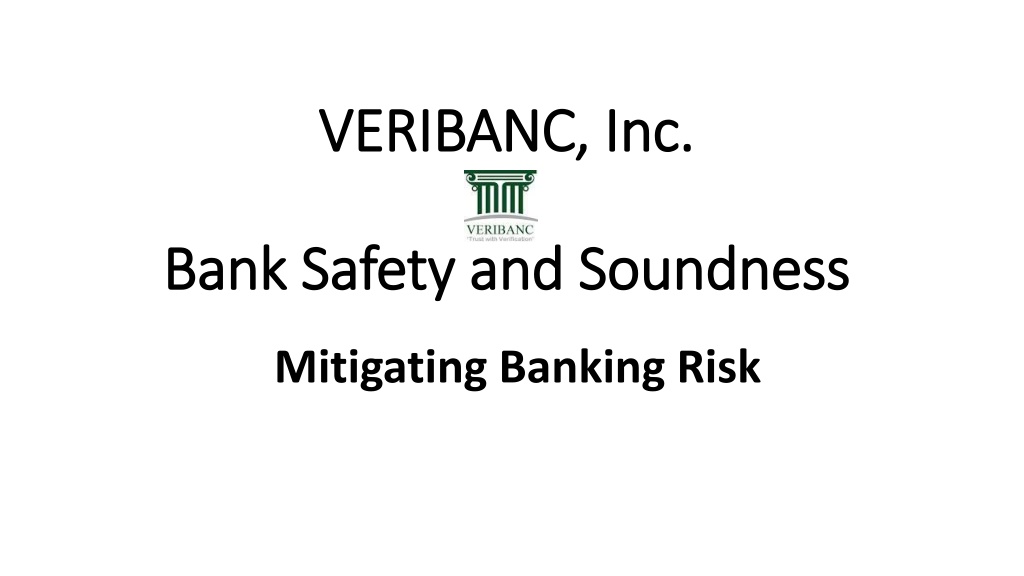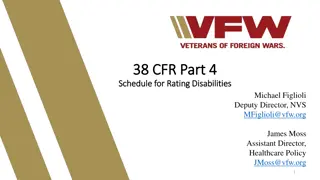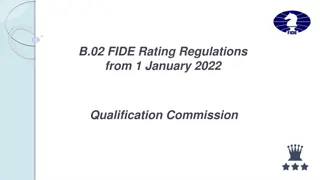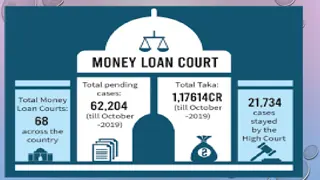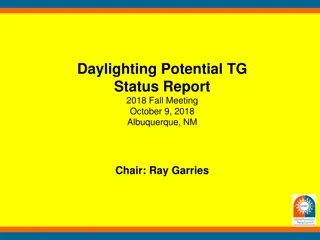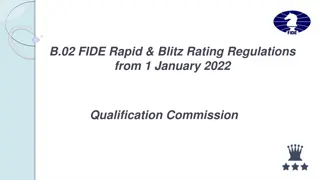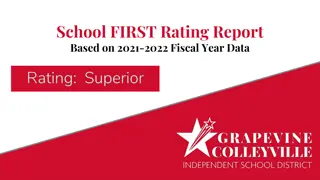Understanding VERIBANC Rating System for Financial Institutions
The VERIBANC rating system provides a simple two-part color code and star classification to assess financial institutions' current standing and future outlook. It considers factors like capital strength, asset quality, management ability, earnings sufficiency, liquidity, and market risk sensitivity. Institutions are categorized into green, yellow, or red based on their equity and financial performance. Compliance with regulatory capital measures and assessment of problem loans are crucial in determining an institution's health and potential corrective actions by regulatory authorities.
Download Presentation

Please find below an Image/Link to download the presentation.
The content on the website is provided AS IS for your information and personal use only. It may not be sold, licensed, or shared on other websites without obtaining consent from the author. Download presentation by click this link. If you encounter any issues during the download, it is possible that the publisher has removed the file from their server.
E N D
Presentation Transcript
VERIBANC, Inc. VERIBANC, Inc. Bank Safety and Soundness Bank Safety and Soundness Mitigating Banking Risk
MASSACHUSETTS COLLECTORS & TREASURERS ASSOCIATION PARTNERED WITH VERIBANC - MCTA TRAINING MANUAL BACK IN 1993 - RATINGS/TIERS - BLUE RIBBON (BB) - FAILURES - DEMO - DEPOSIT INSURANCE and DIF - COMMUNITY BANK LEVERAGE RATIO (CBLR) - SUMMARY (800-837-4226)
THE VERIBANC RATING SYSTEM It s simple and it works! VERIBANC, Inc. s two-part color code and star classification system rates financial institutions from two perspectives -- present standing and future outlook. It takes into account many financial ratios and measures, including all six factors Federal regulators utilize in determining the government s CAMELS ratings. These factors include an institution s Capital strength, Asset quality, Management ability, Earnings sufficiency, Liquidity, and Sensitivity to market risk.
The institutions equity exceeds a modest percentage of its assets and it had positive net income during the most recent reporting period. Of the three color categories, this is the highest based on the criteria described. GREEN The institution s equity is at a minimal percentage of its assets or it incurred a net loss during the most recent reporting period. Both of these conditions may apply, if there was a net loss, the loss was not sufficient to erode a significant portion of the institution s equity. The items which result in a yellow color code, merit your attention. YELLOW The institution s equity is less than a minimal percentage of its assets or it incurred a significant net loss during the most recent reporting period (or both). The items, which result in a red color code, deserve your close attention. RED
HOW THE COLOR CODE CRITERIA RELATE TO THOSE USED BY THE FEDERAL BANK REGULATORY AUTHORITIES AND FINANCIAL ANALYSTS Banks and credit unions are required by law to meet a variety of capital measures. When these measures decline below certain norms, the Office of the Controller of the Currency ("OCC"), the Federal Reserve Board ("FRB"), the Federal Deposit Insurance Corporation ("FDIC") or the National Credit Union Administration ("NCUA") initiate remedial measures and the bank is subject to additional monitoring. One norm used in the financial industry is whether or not an institution s equity is at least 5 percent or more of assets. If an institution s equity does not meet specified minimums, regulatory authorities usually take corrective action in the form of compliance orders. PROBLEM LOANS The color code discussed on the Color Code page indicates the institution s actual financial condition as of the reporting date. To help determine the possible future trend of an institution s health, VERIBANC considers information about the amount of money that it has lent or invested in securities for which repayment is late or in doubt. Many institutions maintain loan loss reserves to provide a first line of defense against borrowers who default on their loans and securities investments that go sour. The amount of problem loans, problem securities and securities-type contracts, in excess of an institution s loan loss reserve, measures the degree its equity could suffer as a result of future loan losses. Since they do not directly impact equity or earnings, problem loans, securities and contracts do not affect an institution s color code. However, these items are incorporated into VERIBANC s star classification as described below.
THE VERIBANC STAR CLASSIFICATION In addition to the color code, VERIBANC classifies each institution with Three Stars (***), Two Stars (**), One Star (*) or No Stars (None - "U"). The star classification considers future trends and contingencies not accounted for in the color code. The star classification also incorporates problem assets (along with equity strength and profitability) as a measure of an institution s future prospects. *** An institution must meet the following primary conditions: equity which exceeds five percent of assets, equity as a percentage of assets after deducting problem loans, securities and derivatives contracts in excess of its loan loss reserves must not fall significantly below five percent and the institution must have positive net income for the indicated reporting quarter. An institution (where applicable) must also satisfy all three regulatory capital requirements (see below) and not have any recent serious regulatory sanctions against them. If the institution is a one-bank holding company, neither the holding company nor its member bank has been subject to a recent serious regulatory sanction. In addition, insider lending as a percentage of equity must not be substantial. If the bank is owned by a holding company, all of the holding company's banks, taken together as if they were a single bank, must meet the criteria necessary to receive at least Two Stars. An institution may only have two or fewer volatile periods of asset growth/shrinkage over the past ten quarters. Problem investments also include securities being held to maturity that, if sold, would realize less than their cost.
** An institution meets any two of the three primary conditions for the Three Stars category and has equity that exceeds its unreserved problem loans, securities and derivatives contracts. If the institution had a net loss during the most recent reporting quarter, the loss was not significant. An institution (where applicable) must also satisfy all three regulatory capital requirements (see below) and not have any recent serious regulatory sanctions against them. If the institution is a one- bank holding company, neither the holding company nor its member bank has been subject to a recent serious regulatory sanction. Additionally, if the bank is owned by a holding company, all of the holding company's banks, taken together as if they were a single bank, must meet the criteria necessary for the group to receive at least Two Stars. Two Stars are applied to an institution that has three volatile periods of asset growth/shrinkage over the past ten quarters. For institutions (where applicable) that have held-to-maturity securities investments with a current market value that is less than their cost, that difference must not exceed equity. * An institution meets at least one of the primary conditions required for the Three Stars category, reports equity which exceeds three percent of assets and also exceeds unreserved problem loans, securities and derivatives contracts. If the institution had a net loss during the indicated reporting quarter, the loss was not significant. Moreover, the institution (where applicable) meets at least two of the three federal capital requirements for tier one (core) capital and total capital as a percentage of risk weighted assets and tier one capital as a percentage of average assets. An institution may receive no higher than One Star if it has been subject to a serious regulatory sanction. A one-bank holding company may receive no higher than One Star if the holding company has been subject to a recent serious regulatory sanction. Moreover, if all of the banks in its holding company, taken together as if they were a single bank, receive a One Star or No Stars ("U") rating, the bank may not receive a higher rating than One Star. A One Star rating is assigned if an institution has four or more volatile periods of asset growth/shrinkage over the past ten quarters. Also, an institution (where applicable) may receive a One Star rating if, absent other reasons for downrating as stated above, the difference between cost and current market value of its held-to-maturity securities investments exceeds the institution's equity.
DATA THAT VERIBANC USES - SUMMARY All federally-insured commercial banks and credit unions, by law, must make certain financial records available to federal bank regulatory agencies such as the OCC, FRB, FDIC and the National Credit Union Administration ("NCUA"). The data must be provided to these agencies at specified intervals, usually quarterly. VERIBANC, Inc. has taken the portions of this information which are released to the public periodically by such agencies and has assembled a database that considers every financial institution operating under federal deposit insurance. This includes less than 10,000 depository institutions. A Warning Signal - If VERIBANC s rating system produces a high rating in the color code but confers a low score in the star classification, a warning signal exists. In such a case, the color code indicates the institution s reported basic financials appear strong but the star classification projects some possible deficiencies in other areas. Since the two parts of the rating system examine different criteria, the full color and star rating often hints about the specific nature of an institution s problems. An Investment Grade Rating or Better - In 1994, the VERIBANC Green, Three Stars rating was recognized by the Office of Management and Budget as an investment grade or better rating and as such was acceptable for a letter of credit in which the U.S. Government is the beneficiary.
The VERIBANC Blue Ribbon Bank Commendation of Excellence is the countrys oldest formal recognition of banks which have met exceptionally high standards. Based on Federal Reserve Board data and other criteria, this designation is accorded to those banks that demonstrate exceptional attention to safety, soundness and financial strength. For a bank to qualify for the Blue Ribbon, it must receive VERIBANC s highest Green, Three Stars rating in our eight level rating system, and it must satisfy additional safety related criteria. Our clients who have relied on Blue Ribbon Banks (only one has ever failed*) have had their risk of bank failure virtually eliminated. Nothing beats a Blue Ribbon. On most of our reports the Blue Ribbon Commendation is presented following the safety rating in one of two ways. A single "B" immediately following our rating indicates that this institution has been a Blue Ribbon bank from 1 to 7 consecutive quarters. A double "BB" immediately following our rating indicates that this institution has been a Blue Ribbon bank for 8 or more consecutive quarters. * Fraud committed by the president whereby he was surreptitiously diverting deposits for his personal use.
Average Number of Banks in Each Color Code and Star Classification With Failure Rates Between 1991 and 2022 (5 so far in 2023, most recent, Citizens Bank, Sac City, Iowa) Annualized Failure Rate Per 10,000 Banks/Year 1 3 7 14 67 199 520 3,726 Average No. of Banks in Each Category Average Percentage of Banks in Each Category Color Code and Star Rating Green/*** Green/** Yellow/** Green/* Yellow/* Green/None Yellow/None Red/None 6,344 651 508 263 149 8 34 57 79.18 8.12 6.34 3.28 1.86 0.10 0.42 0.71
DEMO (Q & A)
Massachusetts Collectors and Treasurers Association TREASURER S MANUAL - pg. 2-0 Responsibilities of and Functions Carried Out by the Treasurer The treasurer must determine the cash needs of a municipality and ensure that sufficient liquid assets are available to pay current obligations. All money not required to be kept liquid for purposes of distribution must be invested by the treasurer in such a manner as to require the payment of interest on the money at the highest possible rate reasonably available, taking account of safety, liquidity and yield. (44:55B) - Pg. 11-0 Importance of Cash Management Ch. 44 55B requires that all municipal monies, except those required to be kept liquid for purposes of distribution, be productively invested at the highest possible rate reasonably available, taking account of safety, liquidity, and yield. - pg. 12-6 Investment Services The responsibility of treasurers to invest municipal monies arises under Ch. 44 55B, which imposes upon them the duty to invest all monies not required to be kept liquid for the purposes of distribution. The statute further obligates them to make their investments in such a manner as to require the payment of interest on the money at the highest possible rate reasonably available, taking account of safety liquidity and yield. Ordinarily, municipal monies must be invested in accordance with Ch. 44 55; trust monies must be invested in accordance with Ch. 44 54.
DEPOSIT INSURANCE, PLEDGED SECURITIES, TIME DEPOSITS and the FDIC WHAT OF THE DIF As public finance officers know, the FDIC insures municipal deposits up to $250,000.00 per deposit account. While this is common knowledge in both the private and public sectors, what is often not known are the restrictions on accessibility of funds in the event of a bank failure. As a steward of the public trust and monies, have you ever asked yourself any of the following questions - - - How are pledged securities handled when a bank fails and there is no acquiring institution? Does the FDIC just liquidate the pledged securities upon failure? If so, does the FDIC then pay out the proceeds to the entity whose deposits had the pledged securities agreement? Up to the amount of the deposits? If the pledged securities yield an amount that is greater than the associated deposit amount, what happens to this overage? Do the pledged securities agreements have to be honored by the FDIC? And does the FDIC usually honor them? - - Though the FDIC indicates that state law takes precedence in determining municipal funds accessibility, there are restrictions. And many states revert that authority over funds back to the federal government, effectively removing much of the municipalities ability to control its deposits. In the event there IS an assuming bank, the FDIC has stated that the assuming bank may decide not to honor the original interest rates. As such, the institutions that take over are free to reset interest rates because they re essentially pulling the assets out of bankruptcy , regulators say.
COMMUNITY BANK LEVERAGE RATIO (CBLR) The CBLR is an optional framework that is designed to reduce burden by removing the requirements for calculating and reporting risk-based capital ratios for qualifying community banking organizations that opt into the framework. The framework provides a simple measure of capital adequacy for qualifying community banking organizations, consistent with section 201 of the Economic Growth, Regulatory Relief and Consumer Protection Act. WHY? SAVE TIME AND MONEY HOW?
ARTICLES SUMMARY REMEMBER, WE ARE YOUR PARTNER WE HAVE THE TOOLS and RESOURCES (1993) to RESEARCH ANYTHING (1981) 800-837-4226
